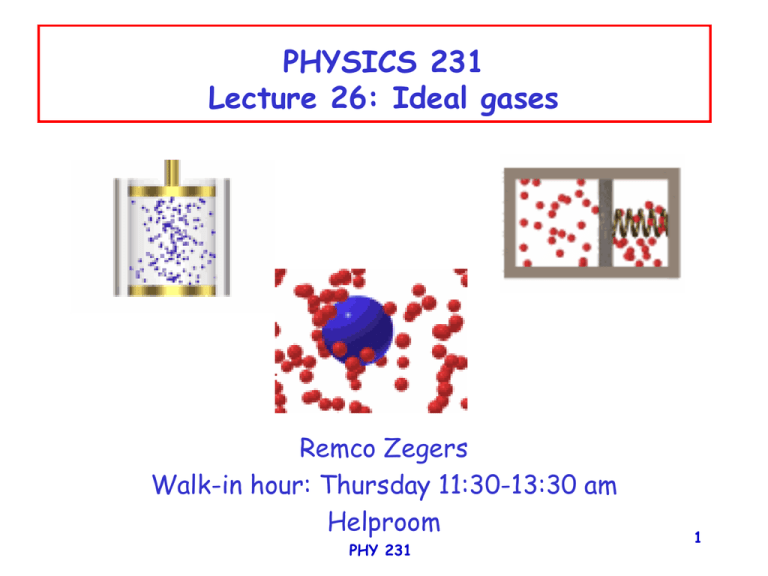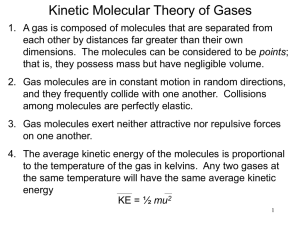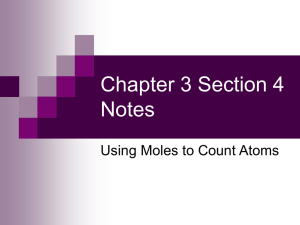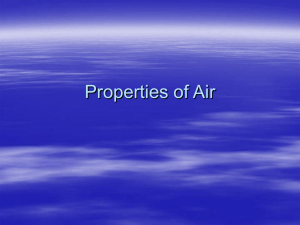1 PHYSICS 231 Lecture 26: Ideal gases
advertisement

PHYSICS 231 Lecture 26: Ideal gases Remco Zegers Walk-in hour: Thursday 11:30-13:30 am Helproom PHY 231 1 Problems in the book for extra practice 8: 39, 41, 47, 51 9: 5, 13, 19, 26, 27, 40, 43, 55 10: 9, 13, 29, 31, 37, 42 11: 1,4,13,21,33 PHY 231 2 Ideal Gas: properties Collection of atoms/molecules that • Exert no force upon each other The energy of a system of two atoms/molecules cannot be reduced by bringing them close to each other • Take no volume The volume taken by the atoms/molecules is negligible compared to the volume they are sitting in PHY 231 3 Potential Energy Rmin 0 -Emin R Ideal gas: we are neglecting the potential energy between The atoms/molecules Potential Energy Kinetic energy 0 R PHY 231 4 Number of particles: mol 1 mol of particles: 6.02 x 1023 particles Avogadro’s number NA=6.02x1023 particles per mol It doesn’t matter what kind of particles: 1 mol is always NA particles PHY 231 5 What is the weight of 1 mol of atoms? Number of protons Name Z X A molar mass PHY 231 6 Weight of 1 mol of atoms 1 mol of atoms: A gram (A: mass number) Example: 1 mol of Carbon = 12 g 1 mol of Zinc = 65.4 g What about molecules? H2O 1 mol of water molecules: 2x 1 g (due to Hydrogen) 1x 16 g (due to Oxygen) Total: 18 g PHY 231 7 Example A cube of Silicon (molar mass 28.1 g) is 250 g. A) How much Silicon atoms are in the cube? B) What would be the mass for the same number of gold atoms (molar mass 197 g) A) Total number of mol: 250/28.1 = 8.90 mol 8.9 mol x 6.02x1023 particles = 5.4x1024 atoms B) 8.90 mol x 197 g = 1.75x103 g PHY 231 8 Boyle’s Law ½P0 2V0 T0 P0 V0 T0 2P0 ½V0 T0 At constant temperature: PHY 231 P ~ 1/V 9 Charles’ law P0 2V0 2T0 P0 V0 T0 If you want to maintain a constant pressure, the temperature must be increased linearly with the volume V~T PHY 231 10 Gay-Lussac’s law P0 V0 T0 2P0 V0 2T0 If, at constant volume, the temperature is increased, the pressure will increase by the same factor P~T PHY 231 11 Boyle & Charles & Gay-Lussac IDEAL GAS LAW PV/T = nR n: number of particles in the gas (mol) R: universal gas constant 8.31 J/mol·K If no molecules are extracted from or added to a system: P1V1 P2V2 PV constant T T1 T2 PHY 231 12 Example An ideal gas occupies a volume of 1.0cm3 at 200C at 1 atm. A) How many molecules are in the volume? B) If the pressure is reduced to 1.0x10-11 Pa, while the temperature drops to 00C, how many molecules remained in the volume? A) PV/T=nR, so n=PV/(TR) R=8.31 J/molK T=200C=293K P=1atm=1.013x105 Pa V=1.0cm3=1x10-6m3 n=4.2x10-5 mol n=4.2x10-5*NA=2.5x1019 molecules B) T=00C=273K P=1.0x10-11 Pa V=1x10-6 m3 n=4.4x10-21 mol n=2.6x103 particles (almost vacuum) PHY 231 13 And another! An airbubble has a volume of 1.50 cm3at 950 m depth (T=7oC). What is its volume when it reaches the surface (water=1.0x103 kg/m3)? P950m=P0+watergh =1.013x105+1.0x103x950x9.81 =9.42x106 Pa P1V1 P2V2 T1 T2 5 9.42 106 1.50 106 1.013 10 Vsurface 280 293 Vsurface=1.46x10-4 m3=146 cm3 PHY 231 14 Correlations A volume with dimensions LxWxH is kept under pressure P at temperature T. A) If the temperature is Raised by a factor of 2, and the height of the volume made 5 times smaller, by what factor does the pressure change? Use the fact PV/T is constant if no gas is added/leaked P1V1/T1= P2V2/T2 P1V1/T1= P2(V1/5)/(2T1) P2=5*2*P1=10P1 A factor of 10. PHY 231 15 Diving Bell A cylindrical diving bell (diameter 3m and 4m tall, with an open bottom is submerged to a depth of 220m in the sea. The surface temperature is 250C and at 220m, T=50C. The density of sea water is 1025 kg/m3. How high does the sea water rise in the bell when it is submerged? Consider the air in the bell. Psurf=1.0x105Pa Vsurf=r2h=28.3m3 Tsurf=25+273=298K Psub=P0+wg*depth=2.3x106Pa Vsub=? Tsub=5+273=278K Next, use PV/T=constant PsurfVsurf/Tsurf=PsubVsub/Tsub plug in the numbers and find: Vsub=1.15m3 (this is the amount of volume taken by the air left) Vtaken by water=28.3-1.15=27.15m3= r2h h=27.15/r2=3.8m rise of water level in bell. PHY 231 16 A small matter of definition Ideal gas law: PV/T=nR PV/T=(N/NA)R n (number of mols)= N (number of molecules) NA (number of molecules in 1 mol) Rewrite ideal gas law: PV/T = NkB where kB=R/NA=1.38x10-23 J/K Boltzmann’s constant PHY 231 17 From macroscopic to microscopic descriptions: kinetic theory of gases 1) The number of molecules is large (statistical model) 2) Their average separation is large (take no volume) 3) Molecules follow Newton’s laws 4) Any particular molecule can move in any direction with a large distribution of velocities 5) Molecules undergo elastic collision with each other 6) Molecules make elastic collisions with the walls 7) All molecules are of the same type For derivations of the next equation, see the textbook PHY 231 18 Pressure Number of Molecules Mass of 1 molecule Averaged squared velocity 2 N 1 2 P mv 3 V 2 Volume Number of molecules per unit volume Average translation kinetic energy PHY 231 19 2 1 2 PV N mv Microscopic 3 2 Macroscopic PV Nk B T 2 1 2 T ( mv ) 3k B 2 Temperature ~ average molecular kinetic energy 1 3 2 mv k B T Average molecular kinetic energy 2 2 3 3 E kin Nk B T nRT Total kinetic energy 2 2 rms speed of a molecule 3 k T 3 RT b v rms v 2 M=Molar mass (kg/mol) m M PHY 231 20 example What is the rms speed of air at 1atm and room temperature? Assume it consist of molecular Nitrogen only (N2)? vrms 3k bT 3RT v m M 2 R=8.31 J/molK T=293 K M=2*14x10-3kg/mol vrms=511 m/s !!!!! PHY 231 21 And another... What is the total kinetic energy of the air molecules in the lecture room (assume only molecular nitrogen is present N2)? 1) find the total number of molecules in the room PV/T= Nkb P=1.015x105 Pa V=10*4*25=1000 m3 kb=1.38x10-23 J/K T=293 K N=2.5x1028 molecules (4.2x104 mol) 2) Ekin=(3/2)NkBT=1.5x108J (same as driving a 1000kg car at 547.7 m/s) PHY 231 22








